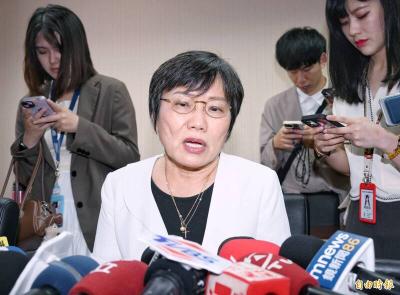President Ma Ying-jeou (馬英九) did not denigrate the country’s sovereignty by describing the country’s relationship with China as “special across the Taiwan Strait” but not state-to-state, the Presidential Office said yesterday.
Presidential Office Spokesman Wang Yu-chi (王郁琦) said that under the 11th amendment of the Constitution and the Statute Governing the Relations Between the Peoples of the Taiwan Area and Mainland Area (台灣地區與大陸地區人民關係條例), the relationship between Taiwan and China is one between two regions.
“It is between the “Taiwan region” and “mainland region,” he said. “The Republic of China [ROC] is an independent sovereign state. Although both sides cannot recognize each other, at least we manage not to deny each other.”

PHOTO: LIAO CHEN-HUEI, TAIPEI TIMES
Wang denied that Ma’s theory would hurt the country’s sovereignty, saying that it was undeniable the ROC was an independent sovereignty and the relationship between the “Taiwan region” and the “mainland region” is an equal one.
Since it is an equal relationship, Wang said there was no downgrading of sovereignty.
The Constitution was enacted in China and was frozen in April 1948. Four months later it was replaced by the Temporary Provisions Effective during the Period of National Mobilization for the Suppression of the Communist Rebellion (動員勘亂時期臨時條款). The temporary provisions were abolished in May 1991 and the Constitution was reinstated.
Asked by the Taipei Times whether the Constitution was relevant to Taiwan’s current situation, Wang said that nobody has questioned its propriety and that the legitimacy of the ROC government comes from the Constitution.
“There is no doubt [that the Constitution is suitable for Taiwan],” he said. “Besides, several amendments have been made over the years.”
While both sides could not resolve the dispute of Taiwan’s sovereignty, Ma has proposed relying on the so-called “1992 consensus.” Under the “consensus,” Ma said each side accepted the principle of “one China” but agreed to have its own interpretation of what it meant. Many in Taiwan dispute the validity of the alleged consensus.
Asked how the government expected to resolve the sovereignty issue given such a dispute, Wang said the two sides must shelve controversial issues and begin talks on issues they both agree on.
DIFFERENCES SET ASIDE
The reason the administration could deliver on its promises of implementing cross-strait weekend charter flights, increase the number of Chinese tourists visiting Taiwan and expand the “mini three transportation links” was because both sides put aside their differences, Wang said.
While it remained to be seen whether Beijing would reciprocate the goodwill Ma has extended with his “non state-to-state” theory, Wang said Ma made it clear that the public must look at cross-strait relations from the perspective of the ROC Constitution and the Statute Governing the Relations Between the Peoples of the Taiwan Area and Mainland Area.
Meanwhile, Mainland Affairs Council Chairwoman Lai Shin-yuan (賴幸媛), once a proponent of former president Lee Teng-hui’s (李登輝) “special state-to-state” theory of cross-strait relations, skirted questions yesterday about Ma denying the applicability of the theory.
PRESS CONFERENCE
Lai was bombarded with questions about Ma’s stance at a press conference held after the weekly Cabinet meeting.
Asked whether she preferred Lee or Ma’s theory and how she would interpret Ma’s stance, Lai repeated the principles Ma has set out about his policy.
“Everyone knows the Republic of China is an independent state, which is an established fact. Under the Constitution, what the Act Governing Relations between Peoples’ of the Taiwan Area and the Mainland Area stipulates were called the Taiwan area and the Mainland,” Lai said.
She stressed the government’s cross-strait policies were based on the three principles of “no unification, no independence and no use of force” to maintain cross-strait stability and pursue reconciliation.
Asked why Ma had decided to forgo the special state-to-state relationship if the ROC is an independent state, Lai said the government wanted to set aside politically complex and controversial issues in cross-strait relations.
“To advance cross-strait ties one should start with economic and pragmatic issues,” she said. “Shelving complicated and controversial issues will benefit the country.”
Approached by cable TV reporters after the press conference, Lai quickly left the room.
DPP LASHES OUT
The Democratic Progressive Party (DPP) caucus attacked Ma yesterday for downgrading himself, saying it was outrageous he would blur the country’s sovereignty, and demanding he apologize to the public for his inappropriate interpretation of “district to district.”
“Whether in the name Republic of China or Taiwan, according to constitutional appendices and amendments, it is undeniable that we are a country where sovereignty belongs to the people,” DPP’s Department of Culture and Information director Cheng Wen-tsang (鄭文燦) said.
“Since when did Taiwan become Taiwan district? Would Taiwan district have the right to join the UN and would it be necessary for Taiwan district to maintain diplomatic allies?” Cheng said.
“People are enraged,” DPP Legislator Tsai Huang-liang (蔡煌瑯) said.
“Ma’s statement is self-castrating ... If Ma thinks that by giving up sovereignty and lying low China will return the favor, he is wrong,” Tsai said.
Several Chinese Nationalist Party (KMT) legislators, however, praised Ma’s stance.
KMT caucus deputy secretary-general Wu Yu-sheng (吳育昇) dismissed the DPP’s criticism, saying Ma’s remarks were in line with the Constitution.
Legislative Speaker Wang Jin-pyng (王金平), a KMT member, said it was meaningless for the nation to focus too much on the sovereignty issue and it was more important to deliberate on how to promote the economy and cross-strait relations.
Also See: EDITORIAL:Doublespeak hides Ma’s agenda

Chinese Nationalist Party (KMT) Chairman Eric Chu (朱立倫), spokeswoman Yang Chih-yu (楊智伃) and Legislator Hsieh Lung-chieh (謝龍介) would be summoned by police for questioning for leading an illegal assembly on Thursday evening last week, Minister of the Interior Liu Shyh-fang (劉世芳) said today. The three KMT officials led an assembly outside the Taipei City Prosecutors’ Office, a restricted area where public assembly is not allowed, protesting the questioning of several KMT staff and searches of KMT headquarters and offices in a recall petition forgery case. Chu, Yang and Hsieh are all suspected of contravening the Assembly and Parade Act (集會遊行法) by holding

PRAISE: Japanese visitor Takashi Kubota said the Taiwanese temple architecture images showcased in the AI Art Gallery were the most impressive displays he saw Taiwan does not have an official pavilion at the World Expo in Osaka, Japan, because of its diplomatic predicament, but the government-backed Tech World pavilion is drawing interest with its unique recreations of works by Taiwanese artists. The pavilion features an artificial intelligence (AI)-based art gallery showcasing works of famous Taiwanese artists from the Japanese colonial period using innovative technologies. Among its main simulated displays are Eastern gouache paintings by Chen Chin (陳進), Lin Yu-shan (林玉山) and Kuo Hsueh-hu (郭雪湖), who were the three young Taiwanese painters selected for the East Asian Painting exhibition in 1927. Gouache is a water-based

Taiwan would welcome the return of Honduras as a diplomatic ally if its next president decides to make such a move, Minister of Foreign Affairs Lin Chia-lung (林佳龍) said yesterday. “Of course, we would welcome Honduras if they want to restore diplomatic ties with Taiwan after their elections,” Lin said at a meeting of the legislature’s Foreign Affairs and National Defense Committee, when asked to comment on statements made by two of the three Honduran presidential candidates during the presidential campaign in the Central American country. Taiwan is paying close attention to the region as a whole in the wake of a

OFF-TARGET: More than 30,000 participants were expected to take part in the Games next month, but only 6,550 foreign and 19,400 Taiwanese athletes have registered Taipei city councilors yesterday blasted the organizers of next month’s World Masters Games over sudden timetable and venue changes, which they said have caused thousands of participants to back out of the international sporting event, among other organizational issues. They also cited visa delays and political interference by China as reasons many foreign athletes are requesting refunds for the event, to be held from May 17 to 30. Jointly organized by the Taipei and New Taipei City governments, the games have been rocked by numerous controversies since preparations began in 2020. Taipei City Councilor Lin Yen-feng (林延鳳) said yesterday that new measures by